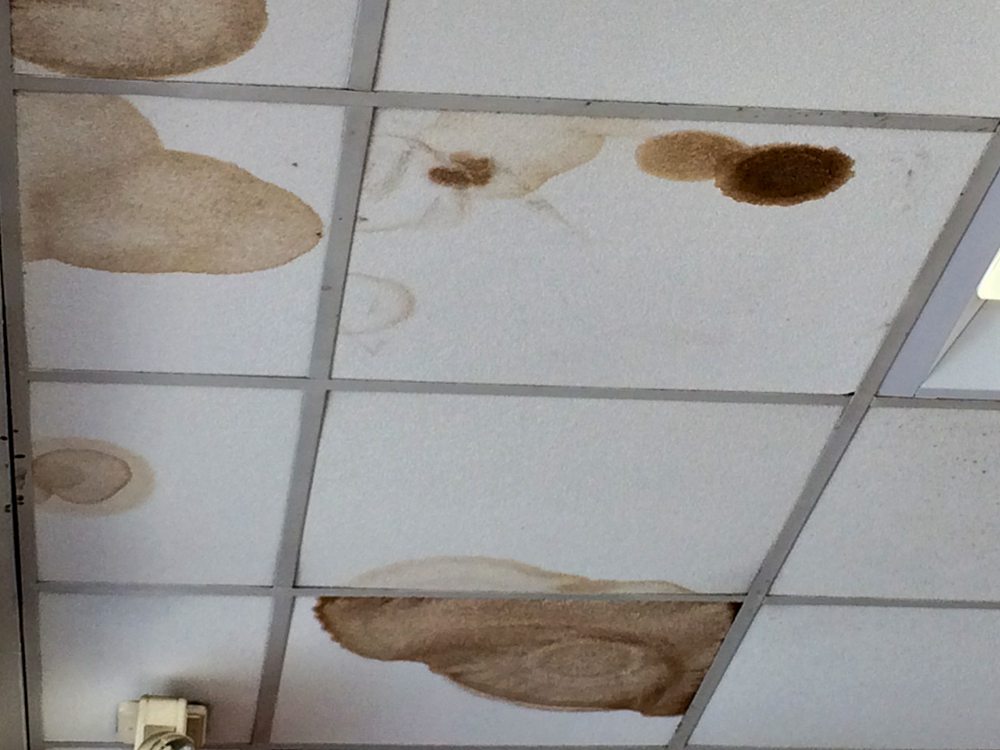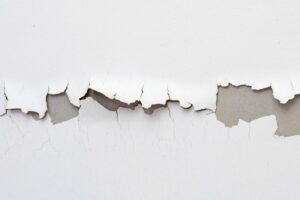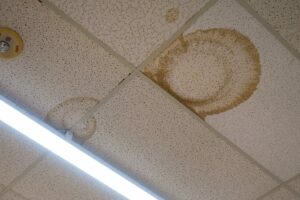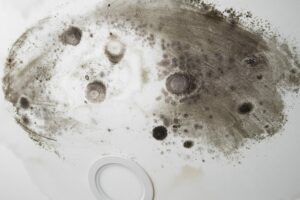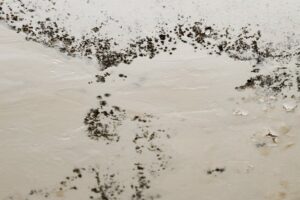Brown spots on your ceiling can be unsightly and concerning. They may start small but can grow and spread over time. Identifying the cause of the spots is key to determining if they are a cosmetic issue or a sign of serious damage that requires repair. This article explores the common causes of brown ceiling spots, health and safety concerns, and solutions for treatment and prevention.
Table of Contents
What Causes Brown Spots on Ceilings?
There are several potential causes of brown spots on your ceiling:
Water Damage
Water leaks are the most common cause of brown stains on ceilings. Sources of water leaks include:
- Plumbing leaks – Leaking pipes, overflowing toilets or bathtubs, malfunctioning appliances like dishwashers can all lead to water seeping through ceilings.
- Roof leaks – Faulty or aging roofs may develop cracks that allow water intrusion during rain or snow.
- Condensation – High humidity levels can lead to condensation on cold ceiling surfaces which leads to water accumulation.
Water damage often starts as small brown spots but can spread if not quickly remedied. The brown stains are caused by water mixing with dust and particles on ceiling material like drywall or plaster. Mold growth may also occur if water damage is excessive.
Settling Dust and Dirt
Dust, dirt, and other particulate matter in the air can settle on ceiling surfaces over time. As these particles accumulate, they can form brown stains, especially around vents, fans, or fixtures. General air circulation, cleaner air filters, and regular cleaning can minimize dust buildup.
Nicotine and Smoke
Secondhand smoke from cigarettes or other tobacco products can discolor ceilings. The tar and nicotine in smoke adhere to ceiling materials, forming yellow or brown stains over time. Proper ventilation is key to preventing excessive smoke residue.
Paint Issues
Problems with ceiling paint can also lead to brown spots. If ceiling paint was applied incorrectly or is old and degraded, it may start flaking or peeling. Bubbling or cracking paint exposes the bare ceiling material underneath, which then appears discolored. Moisture damage, poor preparation, and inferior quality paint can all cause paint failure.
Mold or Mildew
In damp environments, mold and mildew growth can occur on ceiling surfaces and HVAC ductwork. This growth starts off as small brown or black specks but spreads into larger spotted stains if uncontrolled moisture issues persist. Controlling humidity levels is key to inhibiting mold.
Leaking Pipes or Vents
Leaking plumbing pipes or HVAC vents in the space above the ceiling can lead to moisture damage and rust stains. Telltale signs include brown spots that are clustered directly underneath joints or vents. Left unresolved, leaks can rot wooden framing and cause structural instability.
Metal Oxide Staining
Some building materials like drywall joint compound contain trace metals that can oxidize over time, resulting in brownish discoloration. This often occurs due to moisture exposure. Proper ventilation helps minimize oxidation.
Health and Safety Concerns with Ceiling Spots
While cosmetic issues are the most obvious impact of ceiling stains, certain causes also raise health and safety concerns that require prompt attention:
- Water damage – Excessive moisture from leaks promotes mold growth associated with allergies, asthma, and respiratory issues. It also risks wood rot and instability if left untreated.
- Mold/mildew – Mold spores trigger allergic reactions and more severe complications in those with asthma, lung disease, or compromised immune systems. Prolonged exposure has been linked to respiratory illness.
- Nicotine/tobacco stains – Secondhand smoke residue poses cancer risks and can trigger reactions in those sensitive to tobacco. It also indicates poor air circulation.
- Rust stains from HVAC issues – Rust from leaking vents or pipes above the ceiling may indicate larger problems with HVAC systems. Faulty systems can lead to improper ventilation, humidity, and indoor air contaminants.
- Peeling paint – Chipping, flaking, or bubbling paint on ceilings may contain lead in older buildings. Lead dust inhalation poses neurological risks, especially to children. Newer paint issues may signal underlying moisture damage.
These concerns emphasize the importance of identifying and resolving the root causes of brown ceiling stains promptly. Seeking professional assessment is recommended for any spots indicative of excessive moisture, mold, HVAC issues, or lead paint risks.
Inspecting and Testing for the Cause
The first step in dealing with brown spots on your bathroom ceiling is trying to identify the cause through careful inspection and testing:
Visual Inspection
- Examine the size, shape, color, and distribution of spots. Mold stains tend to have fuzzy edges and grow in clusters while water stains often have defined edges and light centers.
- Note the location of spots in relation to moisture sources like vents, pipes, windows. This may provide clues to leak sites or rust sources.
- Look for signs of water damage like cracks, peeling paint, or soft drywall. Use a moisture meter to check for hidden damp areas.
- Determine if discoloration resembles paint aging vs concentrated stains. Check for associated paint bubbling or peeling.
Odor Test
- Mold growth has a musty, earthy smell. Gently rub a spot and sniff your fingers. Rust has a metallic odor.
Humidity Level Check
- Use a hygrometer to measure bathroom humidity levels. Consistently high humidity over 50% encourages mold growth.
- Note if exhaust fan is regularly used and windows opened to ventilate. Lack of ventilation allows humid air to accumulate.
Allergy Symptom Monitoring
- Monitor if brown spots correspond to allergic reaction symptoms like sneezing, coughing, or respiratory irritation for those using the bathroom. Mold can exacerbate allergies.
Mold Testing Kits
- If needed for confirmation, mold testing kits check samples for mold spores. This helps identify mold types to determine if they are toxic varieties. Professional mold testing can also be performed.
By thoroughly inspecting brown spots for characteristics, checking for correlated humidity/ventilation issues, noting any moldy odors, and monitoring allergy symptoms, you can typically determine if mold or another cause is to blame. Seek professional mold testing if the cause remains uncertain.
Solutions for Treating Brown Spots on Ceilings
Here are some general guidelines for treating different causes of brown ceiling spots:
Water stains
- Repair any plumbing or roof leaks immediately to limit further water damage
- Allow ceiling area to fully dry then scrub stain gently with diluted bleach solution to kill mold and lighten staining
- Repaint stained areas with mold-inhibiting primer and ceiling paint
- Signs of recurring stains or wood instability indicate professional repair is needed
Dust/dirt accumulation
- Wash ceiling using warm water and mild detergent solution
- Use soft brush attachment on vacuum for periodic dusting
- Improve home ventilation and air filtration systems
- Have ductwork professionally cleaned if spots reappear quickly
Smoke/tobacco stains
- Light stains can be removed by scrubbing with baking soda paste and vinegar solution
- Heavier stains may require chemical stain remover designed for smoke damage or repainting
- Eliminate sources of tobacco smoke
- Install proper exhaust and ventilation
Peeling/flaking paint
- Address any underlying moisture damage causing the paint failure
- Remove all loose or bubbling paint
- Sand rough edges to create smooth surface for repainting
- Seal stains with oil-based primer
- Repaint with two coats of quality ceiling paint
Mold/mildew stains
- Clean off surface mold gently with bleach solution
- Address and eliminate sources of moisture supporting mold growth
- Use primer with mold-blocking additives before repainting
- Be sure to wear protective mask when working with possible mold
Rust stains from HVAC issues
- Have HVAC system inspected by professional to identify and repair leaks
- Scrub stains gently with oxalic acid solution
- Repaint ceiling with rust-inhibiting primer
Metal oxide stains
- Improve ventilation to minimize further oxidation
- Scrub stains gently with oxalic or phosphoric acid solution
- Prime and repaint affected areas
Solutions for Removing Brown Spots from Bathroom Ceilings
If your bathroom has developed unsightly brown stains, don’t panic. There are a variety of solutions for safely removing them and restoring your ceiling’s surface. Which option(s) will work best depends on the extent and cause of staining.
Cleaning with Bleach
For mild brown stains from mildew and mold growth, mixing up an all-purpose cleaner with bleach can often remove discoloration. Be sure to take proper safety precautions when using bleach products. You’ll need:
- 1/2 gallon of warm water
- 1/4 cup bleach
- 1/4 cup all-purpose cleaner
- Clean sponge or rag
Mix the water, bleach, and cleaner together in a bucket. Use a sponge or rag dipped in the solution to scrub stained areas of the ceiling. Let it sit for 5-10 minutes before rinsing clean with fresh water. Allow to fully dry. Repeat if needed for stubborn stains. This should kill and remove surface mold and mildew growth.
Vinegar Solution
For mild stains or paint discoloration, a dilute vinegar solution often works well too. The acidic vinegar disinfects and eats away at staining. Mix a solution of one part white vinegar to one part water and scrub onto affected areas. Let sit briefly before rinsing clean with water. Repeat if needed.
Baking Soda Paste
For more stubborn brown spots caused by mold or mildew, try making a paste with baking soda. The abrasive texture of the baking soda scours the stains while the alkaline properties disinfect and deodorize. Mix 1/4 cup baking soda with just enough water to form a thick paste. Apply it directly to stained patches on the ceiling with a scrub brush or sponge. Let it sit for 10-20 minutes before rinsing clean. Repeat as needed.
Commercial Ceiling Cleaners
There are several mildew stain remover products available at home improvement stores specifically designed for bathroom ceilings and tiles. Carefully read labels and choose an appropriate product for your needs. Apply the cleaner per product instructions. Most require letting it soak in for some time before scrubbing and rinsing away.
Repainting
For widespread ceiling discoloration or recurring stains that cleaning solutions aren’t tackling, repainting the ceiling may be required. Properly prep and prime the surface, then apply at least two coats of a mildew resistant bathroom paint in a satin or semi-gloss sheen, which can withstand humidity better than a flat finish. Be sure to address any underlying moisture issues first or the stains are likely to return through the new paint.
Table: Summary of Ceiling Stain Removal Solutions
| Solution | Best For | Things to Note |
|---|---|---|
| Bleach Cleaner | Mild mildew stains | Use proper safety precautions, ventilate well |
| Vinegar Solution | Mild stains, paint discoloration | Safe and natural option, may require multiple treatments |
| Baking Soda Paste | Stubborn, heavy mildew stains | Scrubs away tough staining |
| Commercial Cleaners | Mildew and mold stains | Check label for appropriate product/surface use |
| Repainting | Widespread stains, recurring issues | Address underlying moisture problems first |
Prevention Tips
Removing existing brown spots from your bathroom ceiling is only half the battle. You’ll also want to take steps to prevent them from returning or occurring in the first place.
Improve Ventilation
Lack of proper moisture ventilation is one of the most common factors leading to recurring bathroom ceiling mold and mildew. Make sure your bathroom has an exhaust fan and that you use it consistently during and after baths and showers. Run it for about 20 minutes after the room is already dry to ensure excess moisture has been vented out.
Open windows periodically if possible or consider installing a ceiling ventilator fan triggered by humidity levels. Getting moisture and humidity down is key to preventing ideal mold growth conditions.
Fix Plumbing Leaks Promptly
Don’t delay in fixing any water leaks in bathroom pipes, fixtures, tiles or the ceiling itself. Leaks provide a wet surface for mold to thrive. Stopping the flow of water removes this enabling condition. Be proactive with checking the condition of bathroom caulking, grout and plumbing components to identify and address leaks before they lead to moisture damage.
Clean Regularly
Get into the habit of regularly cleaning and disinfecting bathroom walls, fixtures and horizontal surfaces where mold and mildew are likely to grow. Monthly scrub downs using bleach, vinegar or other antimicrobial cleaners will kill existing mold and help prevent it from getting established. Pay extra attention to grout, caulking, window tracks and corners that tend to collect moisture and grime.
Consider a Dehumidifier
For bathrooms prone to excess humidity, a small electric dehumidifier can help regulate moisture levels in the air. This also makes the room less hospitable for mold growth. Choose a unit appropriately sized for the bathroom square footage and run it daily. Keep humidity maintained below 50% if possible.
Use Mold Resistant Paint
When it’s time to repaint the bathroom, use a high quality mold and mildew resistant paint. Look for products specially formulated for humid, high moisture rooms like bathrooms. They will include agents to inhibit mold and mildew growth on the surface. Semi-gloss or satin finishes also withstand moisture better than flat paint.
FAQ About Brown Spots on Bathroom Ceilings
What are some quick ways to identify the cause of brown spots on a bathroom ceiling?
Some quick checks are looking at the spot’s characteristics like shape, location, and distribution for clues, smelling for musty odors indicative of mold, feeling for moisture or damage around spots, and monitoring allergy symptoms of bathroom users that may point to mold exposure.
Is it safe to paint over brown spots on a bathroom ceiling?
Painting over spots without addressing the root cause first is not recommended. Moisture or mold issues should be fully resolved before repainting to avoid stains bleeding through. Using a stain-blocking primer helps prevent this.
How can you confirm mold growth on a bathroom ceiling?
Beyond visible inspection and musty odors, mold testing kits check samples for mold spores. Professionals can take samples for lab testing to positively identify toxic mold types present. Consider testing if multiple allergy symptoms occur in the bathroom.
What level of bathroom humidity encourages mold growth on ceilings?
Consistently high humidity over 50% provides optimal conditions for mold. Good ventilation through fans, windows, and dehumidifiers helps keep humidity below 50% to deter mold.
How often should you inspect a bathroom ceiling?
It’s smart to do periodic quick visual inspections of your bathroom ceiling every 1-3 months. Look for any new brown spots or moisture signs appearing. Check areas near ceiling vents, pipes, windows. Catching issues early makes removal easier.
Conclusion
If brown spots arise on your bathroom ceiling, don’t ignore them as they likely indicate a moisture issue or mold growth needing addressed. Carefully inspect spots and bathroom conditions to diagnose the likely cause. Take proper steps to fully eliminate the root problem before repairing ceiling aesthetics with cleaning or repainting. Implement preventive measures like humidity control and ventilation to avoid brown spots from recurring and creating health hazards. Addressing brown ceiling spots promptly can help catch and fix underlying bathroom moisture and mold problems before they worsen or spread.


